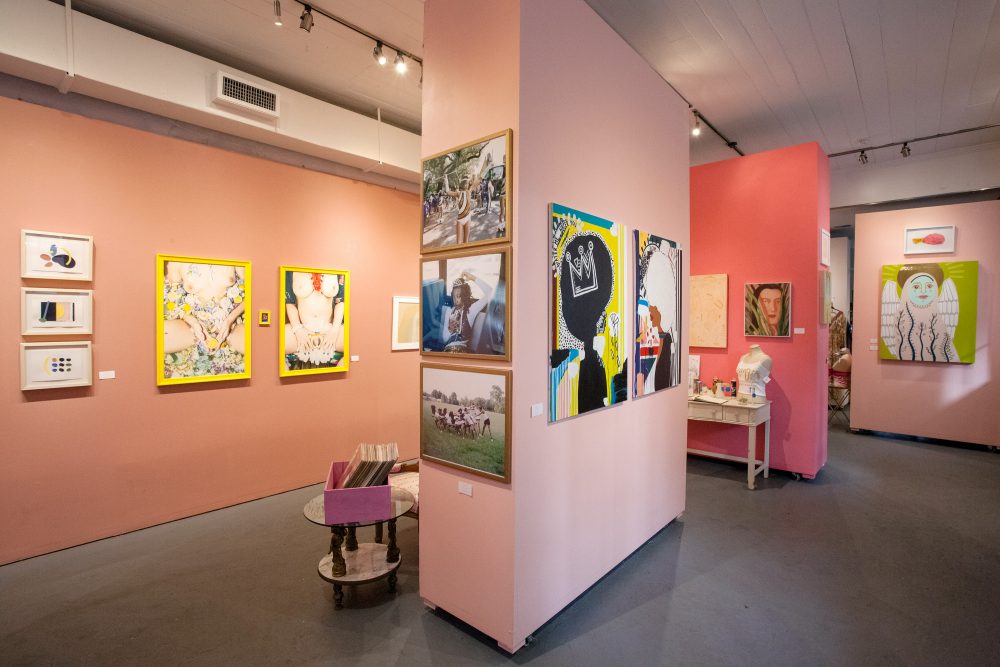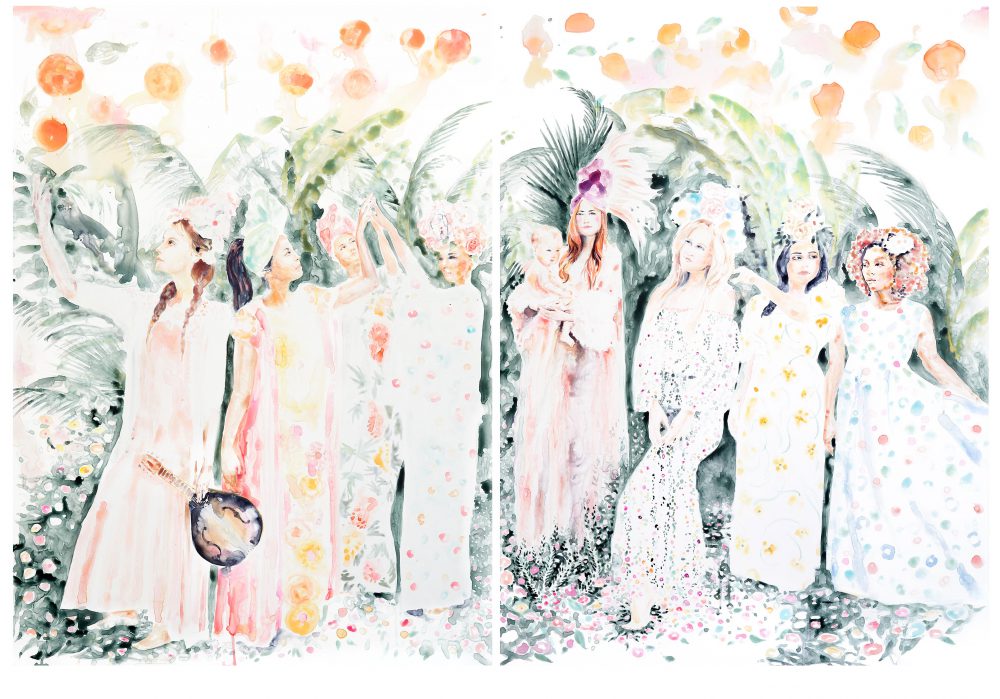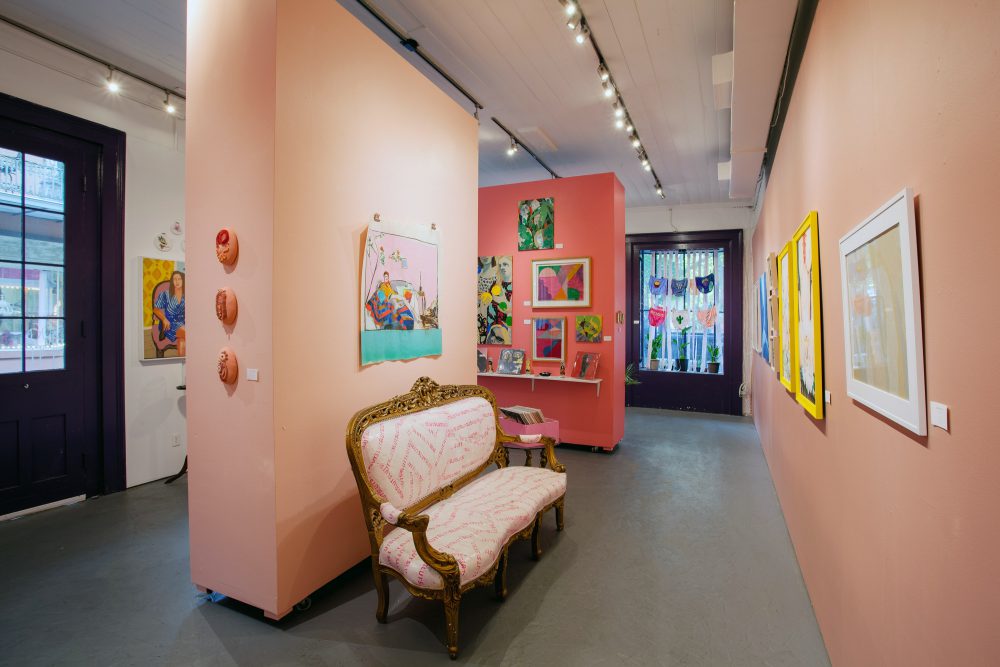From Instagram to IRL: An Interview with Madeline Rose and Halle Kaplan-Allen
Taylor Murrow talks to the creators of Femaissance about their dreams to build a collaborative community of female artists.

Installation view of “Femaissance: Primavera” at Oleander on Royal, New Orleans. Courtesy Oleander on Royal, New Orleans. Photo by Sonia Kissin.
Editor's Note
Madeline Rose and Halle Kaplan-Allen have coated the walls of Oleander on Royal gallery in Millennial Pink. A Baroque-inspired sofa, plastered in wallpaper with the word “SLUT” printed in electric fuchsia, sits in the gallery’s center. The art on view is unapologetically feminine, with the centerpiece being a watercolor painting by Lyla Clayre, created after a photo shoot recreating Italian master Sandro Botticelli’s 15th-century Primavera. Oleander on Royal is the home of Femaissance, a project that spotlights local women artists and makers working in many media, and this show includes works by Artemis Antippas, Ansley Givhan, Robyn LeRoy-Evans, Leroy’s Place, Marrow Creative, Mira Ceramics, Akasha Rabut, and Maddie Stratton.
Rose and Kaplan-Allen met when they were students at Tulane University and are now focused on nurturing their community of artists through exhibitions and programming aiming to empower and mobilize women. Their second exhibition, “Femaissance: Primavera,” opened April 14. I talked to them about creating community and the role social media plays in their curatorial vision.
—Taylor Murrow
Taylor Murrow: Describe Femaissance. How did you two create this project?
Madeline Rose: Femaissance is a collaboration celebrating collaboration and is our response, or initially was our response, to the climate of the Trump era, and just being young women in our twenties. We were given the opportunity by the gallery director to create an all-female space. We were also influenced by what we were seeing with other projects around the country, notably with The Wing in New York.
That’s Femaissance. It’s a New Orleans-based, female-centric project that is rooted in both activism and artistry. The whole concept is for it to be both an exhibition and a community space to host events to bring people together.
TM: How do you see “Femaissance: Primavera” as different from the first time you hosted a Femaissance exhibition?
MR: For the first Femaissance I reached out to artists I found on Instagram. I said, hey, you don’t know who I am, but my name is Maddy, and I’m creating—what at the time was “untitled femme space”—we had no name for it until two weeks before we opened. And all these artists had this blind faith in us to do something. This was also around the time when the Harvey Weinstein scandal broke and the John Besh scandal broke—so I guess there was just a response to the immediacy for this kind of space. I curated that show by pulling images that I liked that fit into a narrative I wanted to portray.
I studied art history in school and for this current exhibition, I knew that I wanted to work with the theme of “Primavera.” I knew this show would happen in the spring, and having this robust army of women allowed me to actually prompt them with a concept and give them a chance to make art [in response to it]. A lot of the work was specifically created for “Primavera” and I think that’s just representative of how the community has grown.
Halle Kaplan-Allen: We both have full-time jobs outside of this, and there have been a lot of moments where I felt like we weren’t going to get it all done, and all it took was a phone call with one of our artists or collaborators to remind us that this is so fulfilling and satisfying and fun, but also important. People are supportive of us with their words and their time. We’ve had countless artists come in and help paint the floors and the walls and just do logistical things. It’s nice to go from having to convince the world that this is something that should happen to having a following and a community of people who are invested in this.

Lyla Clayre, The Garden of Hesperides, 2018. Watercolor on aquabord. Courtesy the artist.
TM: It sounds like there is a lot of collaboration between you and your artists. Do you think part of that is because you’re working with all women?
MR: It’s always been our mission to root this in female collaboration, so that requires not having a huge divide between the curators and the creators and having it be an ongoing dialogue. I think the best example of the collaborative nature of Femaissance is the watercolor diptych by Lyla Clayre. I met Lyla at a pop-up at the gallery called Royal Emporium, a female-centric monthly market that is spearheaded by Alex Kilburn, another one of our artists. I told Lyla about “Primavera,” she came back to me the next day with a rough sketch of the painting, and it completely transformed every idea I had about the curation. I knew this had to be the centerpiece of the show. We had to get together every powerhouse female in the city that we know, and we had to take a photo [Kelsey Campion of Marrow Creative took the photograph], we had to style them in Century Girl Vintage, and we had to try to create this image that just blends everything we’re doing together at this moment because this exhibition is a celebration.
That’s exactly what “Primavera” is, but the show is also looking at Botticelli’s Primavera, this masterful painting that’s beautiful, but treats muses as muse-worthy for their beauty and not for their actions. So we chose our muses, like Erin Romney of Romney Studios, or Robin Barnes the musician, and even Jamie [Lehr], the gallery director. For Lyla, this wasn’t just an appropriation of an image—she wasn’t just looking at an old painting and recreating it—she was on site with us at the Catahoula Hotel when we did that photo shoot, and her painting is the direct impression from that moment, of all of these concepts and different artists and brands and personalities coming together.
TM: What does it mean to be muse-worthy to you?
MR: It’s a word that in New Orleans has so many meanings. It’s funny because we went to the Krewe of Muses parade dressed up as a Krewe of I, Tonyas, which is a funny thing to celebrate, because so much of that film speaks to our propensity to uplift women and also bring them down at the same time. Throughout history we have looked to women to be allegories and to serve as our muses for their looks, and there’s so much more to respect and admire about women—even more perhaps than men because of all the shit we have to deal with all the time. We have crazy beauty standards, and we are also expected to succeed—and to have children while we do all this. Even if you’re not fulfilling that, you’re still muse-worthy. The women that we selected for the photo shoot are complex and multifaceted and have done a lot of different things in their careers. Take someone like Martha Wiggins, who is the former chef of Sylvain—you look at a chef’s arms, every chef, their arms are tattered in burns, and is that stereotypically muse-worthy? Absolutely not, but that’s such a true representation of someone’s hard work and passion and persistence.
TM: Maddy, you mentioned you studied art history in school. Do you both have art backgrounds?
HKA: No I don’t. My role in all this is a lot more of the community and event components. I think it’s really interesting in the social-media age that it’s a constant conversation about how we’re addicted to our phones, and how bad it is for us and how we’re losing the ability to communicate in real life. I’ve always loved Instagram, and I started to think about the ways in which it could be used to facilitate interaction in real life. We both credit Instagram so much for this entire show—we found all of our artists on Instagram, we built our following on Instagram and will continue to do so, but at the end of the day the goal is always to get people to gather in this physical space. We’ve met so many people who’ve said they just came across our page on Instagram, and those are probably people who wouldn’t have just wandered by the gallery.

Installation view of “Femaissance: Primavera” at Oleander on Royal, New Orleans. Courtesy Oleander on Royal, New Orleans. Photo by Sonia Kissin.
TM: I want to get back to what you were saying before about activism and artistry. Where do you see those two meet, and what role does Femaissance play in that?
MR: “Primavera” is the first part of eight weeks of Femaissance at Oleander. Part two is called “Femaissance: Proserpina,” which is an appropriation of Bernini’s The Rape of Proserpina. With “Proserpina,” I had this idea that I wanted to paint this space black, completely turn this project on its head and give it a little bit of an edge. We also felt like we needed to have a stronger response to the #MeToo and #TimesUp movements. It’s such a huge conversation right now, and there’s a lot of art being created in response to that. “Proserpina” is also inspired by the art of the protest poster, as seen in the women’s marches. The way I see it, “Proserpina” will be the protest poster of Femaissance.
I was inspired by this sculpture by Bernini, which depicts the goddess Proserpina [Persephone] being abducted by Pluto, the god of the underworld. She’s forced into marriage with him, and negotiates to spend part of the year on Mount Olympus. In my eyes, she’s just another victim of abuse having to make light of a horrible situation, which is a story that all of us are familiar with. She feels like a good model for triumph despite hardship.
And this theme also stays in the same vein of Roman paganism that is very important to Femaissance as a brand. We’re always trying to see how we can look back to our history, to antiquity and the Renaissance, and pick up themes.
HKA: For both curations we’re planning events that fall in line with the themes that the art portrays. “Primavera” is happening during a fun, touristy, celebratory time in the city, so we’re having parties, a comedy show, some things surrounding Jazz Fest with food vendors and DJs, and the programming we’re thinking of for “Proserpina” is more serious in nature and will hopefully involve conversations about what we can do as a community and individually to keep pushing this world in the direction that we want it to go.
One person we’ve worked with is Caroline Richter, who founded Shift Change, a collective of workers in the service industry trying to fight sexual harassment and assault. The John Besh scandal broke right when we were opening our last show, and we had the idea to host some sort of event to bring together that community and have conversations about how things could change since the service industry is such a big part of the culture here in New Orleans. We’re happy to put our support behind Shift Change. We’re hoping to have some sort of event with them in the space during “Proserpina.” That falls in line with the kind of activism we’re trying to do.
MR: We’re gonna get there, we’re gonna have our moment of truth, but for now we’re existing in this sort of unobstructed moment of celebration. And we know there are more hard times to come—that this isn’t the end of the story—but before all that boils to the surface, you might as well relish this moment.
Editor's Note
“Femaissance: Primavera” is on view through May 27, 2018, at Oleander on Royal (1000 Royal Street) in New Orleans. “Femaissance: Proserpina” opens June 9, 2018.



